|
Bad Ozone
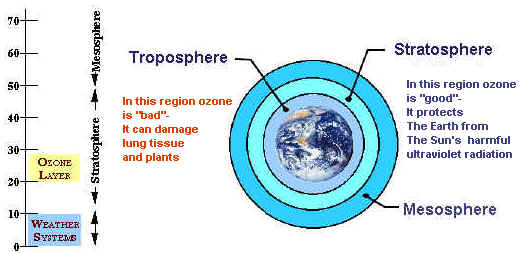
At higher altitudes, where 90 percent
of our planet's ozone resides, it does a remarkable job of absorbing
ultraviolet radiation.
In the absence of this gaseous shield
in the stratosphere, the harmful radiation has a perfect portal through
which to strike Earth.
The amounts of "good" and "bad" ozone
in the atmosphere depend on a balance between processes that create
ozone and those that destroy it. An upset in the ozone balance can have
serious consequences for life on Earth. Scientists are finding evidence
that changes are occurring in ozone levels—the "bad" ozone is increasing
in the air we breathe, and the "good" ozone is decreasing in our
protective ozone shield.
Bad Ozone-
In the Earth’s lower atmosphere, near
ground level, ozone is formed when pollutants emitted by cars, power plants,
industrial boilers, refineries, chemical plants, and other sources react
chemically in the presence of sunlight. Ozone at ground level is a harmful
pollutant. Ozone pollution is a concern during the summer months, when the
weather conditions needed to form it—lots of sun, hot temperatures— normally
occur.
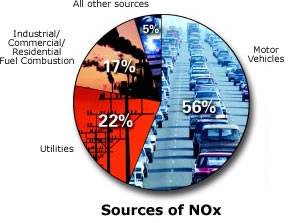 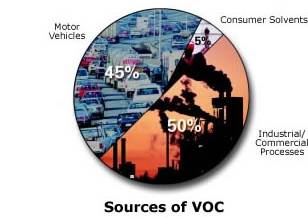
Because it reacts
strongly with other molecules, large concentrations of ozone near the ground
prove toxic to living things. Motor vehicle exhaust and industrial emissions,
gasoline vapors, and chemical solvents are some of the major sources of NOx and
VOC, also known as ozone precursors.
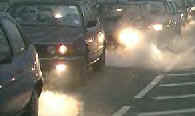
Smog kills more people than Car accidents
Strong sunlight and hot weather cause ground-level ozone to form in harmful
concentrations in the air. Many urban areas tend to have high levels of "bad"
ozone, but other areas are also subject to high ozone levels as winds carry NOx
emissions hundreds of miles away from their original sources.
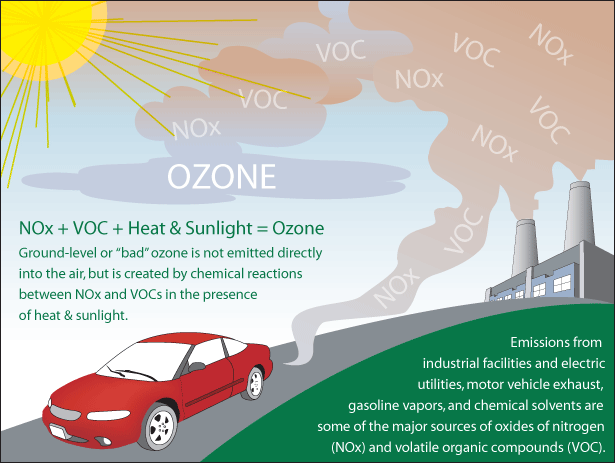
Things That
Affect Ozone Levels
The amount of ingredient gases.
More ingredient gases
(VOC's and NO2) can mean more ozone. Towns and cities that have more
traffic or more industrial plants have a higher potential for ozone
formation, especially towns that also experience many warm sunny days with
little wind.
Weather and Seasons: warm
sunny days mean more ozone.
Since sunlight and heat are
the engines that drive ozone formation, warm sunny days should have more
ozone than cool or cloudy days. Wind can also play a role. On windy days
the wind can disperse the ozone, causing levels to drop. Ozone pollution
can be especially bad during summer heat waves when the air does not mix
very well and air pollution doesn't disperse.
Time of Day: ozone levels
build during the day.
On a clear day, ozone
levels can continue to rise all day long, and then decrease rapidly after
sunset. Since heat, sunlight, the ingredient gasses each usually increase
during the day, ozone formation also increases. When the sun goes down,
there is no energy for ozone formation and fewer ingredient gases - so
ozone levels drop.

The AQI tells you how clean the air is and whether it will affect your health.
Through AIRNow, EPA, NOAA, NPS, state, and local agencies work together
to report current and forecast conditions for ozone and particle pollution.
Air Quality Guide for Ozone
|
Air Quality Index |
Protect Your Health |
Good
(0-50)
|
No health impacts are expected when air quality is in this range. |
Moderate
(51-100)
|
Unusually sensitive people should consider limiting prolonged outdoor
exertion. |
Unhealthy for Sensitive Groups
(101-150)
|
The following groups should limit prolonged outdoor exertion:
- People
with lung disease, such as asthma
- Children
and older adults
- People
who are active outdoors
|
Unhealthy
(151-200) |
The following groups should avoid prolonged outdoor exertion:
- People
with lung disease, such as asthma
- Children
and older adults
- People
who are active outdoors
Everyone else should limit prolonged
outdoor exertion. |
Very Unhealthy
(201-300)
|
The following groups should avoid all outdoor exertion:
- People
with lung disease, such as asthma
- Children
and older adults
- People
who are active outdoors
Everyone else should limit outdoor
exertion. |
What You Should Know About Ozone
and Your Health
-
Ozone in the air we breathe can harm our health—particularly on hot, sunny
days when ozone can reach unhealthy levels.
-
Even relatively low levels of ozone can cause health effects.
-
People with lung disease, children, older adults, and people who are active
outdoors may be particularly sensitive to ozone.
-
Ozone exposure may also increase the risk of premature death from heart or
lung disease.
-
This fact sheet tells you how you can find out when air quality is unhealthy
and take simple steps to protect your health.
What is ozone?
Ozone is a colorless gas
found in the air we breathe. Ozone can be good or bad depending on
where it occurs:
-
Ozone occurs naturally in the Earth’s upper atmosphere (the
stratosphere), where it shields the Earth from the sun’s ultraviolet
rays.
-
At ground-level, ozone is an air pollutant that can harm human
health.
Where does ground-level
ozone come from?
Ground-level ozone is
formed when two types of pollutants react in the presence of sunlight.
These pollutants are known as volatile organic compounds (VOCs) and
oxides of nitrogen. They are found in emissions from:
-
Vehicles such as automobiles, trucks, buses, aircraft, and
locomotives
-
Construction equipment
-
Lawn and garden equipment
-
Sources that combust fuel, such as large industries and utilities
-
Small industries such as gas stations and print shops
-
Consumer products, including some paints and cleaners
Does my area have high
ozone levels?
-
Ozone is particularly likely to reach unhealthy levels on hot sunny
days in urban environments. It is a major part of urban smog.
-
Ozone can also be transported long distances by wind. For this
reason, even rural areas can experience high ozone levels.
-
The Airnow Web site at airnow.gov provides daily air quality reports
for many areas. These reports use the Air Quality Index (or AQI)
(shown on the first page) to tell you how clean or polluted the air
is.
-
Enviroflash, a free service, can alert you via email when your local
air quality is a concern. Sign up at
www.enviroflash.info
|
How does ozone affect
health?
Ozone can:
-
Make it more difficult to breathe deeply and vigorously.
-
Cause shortness of breath and pain when taking a deep breath.
-
Cause coughing and sore or scratchy throat.
-
Inflame and damage the lung lining.
-
Make the lungs more susceptible to infection.
-
Aggravate lung diseases such as asthma, emphysema, and chronic
bronchitis.
-
Increase the frequency of asthma attacks.
-
Continue to damage the lungs even when the symptoms have
disappeared.
These effects may lead
to increased school absences, visits to doctors and emergency rooms,
and hospital admissions .Research also indicates that ozone exposure
may increase the risk of premature death from heart or lung disease.
Who is sensitive to
ozone?
Some people are more
sensitive to ozone than others. Sensitive groups include children;
people with lung disease, such as asthma, emphysema, or chronic
bronchitis; and older adults. Even healthy adults who are active
outdoors can experience ozone’s harmful effects.
What is an Air Quality
Action Day for Ozone?
Your State or local air
quality agency may declare an Air Quality Action Day for Ozone when
ozone levels are forecast to reach unhealthy levels. On ozone action
days, you can take simple steps (see below) to reduce the pollution
that results in ground-level ozone. |
Keep the
Air Cleaner
|
|
-
Conserve energy-home at work,everywhere. Turn off lights you are not
using.
-
Carpool or use public transportation.
-
When air quality is healthy, bike or walk instead of driving.
-
Combine errands to reduce vehicle trips.
-
Limit engine idling.
-
When refueling: Stop when the pump shuts off. Putting more fuel in
is bad for the environment and can damage your vehicle. Avoid
spilling fuel. Always tighten your gas cap securely.
|
-
Keep your car, boat, and other engines tuned up.
-
Inflate your car’s tires to the recommended pressure.
-
Use environmentally safe paints and cleaning products whenever
possible.
-
Follow manufacturers’recommendations to use and properly seal
cleaners, paints, and other chemicals so smog-forming chemicals
can’t evaporate.
On Air Quality Action Days, you should also:
-
Refuel cars and trucks after dusk,when emissions are less likely to
produce ozone.
-
Delay using gasoline-powered lawn and garden equipment until air
quality is healthy again.
-
Delay using household, workshop, and garden chemicals until air
quality is healthy again.
|
http://airnow.gov
Credit: EPA, NASA
|









